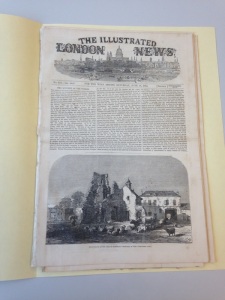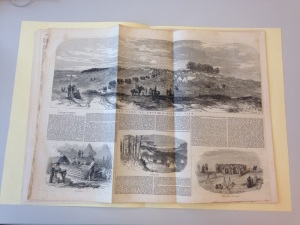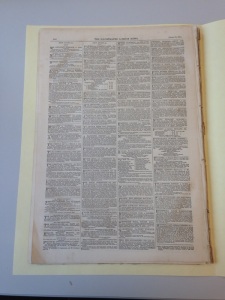 (The Front Page of The Illustrated London News: June 18, 1853)
(The Front Page of The Illustrated London News: June 18, 1853)
The June 18, 1853 edition of The Illustrated London News holds a variety of subjects. These topics range from news of the English Civil War, events in Britain, world news, editorials, announcements from parliament, book releases, music reviews, chess or other games, and more. This print shows what is not only important during this time, but what was also popular. The 23-page paper allows insight to what was happening in Britain in 1853, the lives of their citizens, and amplifies the significance of Southern New Hampshire University’s 1853 collection in understanding historical perspective. Just as newspapers of earlier and later generations, The Illustrated London News gives context to the books written during this time period, such as Charles Dickens’ Bleak House, while also showing the impact and type of British entertainment during the 19th century.
In its 11th year of distribution when this edition was printed, a style had been created and carried out for this newspaper that pertained to a variety of people, giving citizens the opportunity to see the events they could only imagine. According to Gale Digital Collections, this newspaper was the first fully illustrated paper of its kind and the way British citizens were able to not only read their news, but see pictures of these happenings. The History of the Illustrated London News states the newspapers creator, Herbert Ingram, realized while apprenticing for a printing shop at a young age that significantly more copies were sold when a paper offered pictures with their articles. This sparked his initial dream of created a newspaper where multiple pictures were offered with every publication.
The concept sparked what many can now see as a shift in news and entertainment. Throughout the entirety of this specific publication, pictures are printed on entire halves of pages with short descriptions or stories underneath. These pictures show a variety from events like The Bath and West of England Agricultural Society’s Show in Plymouth, the Grand Masonic Ball in Oxford, Hougoumont, On The Field in Waterloo, Camp Kitchen (during war), Artillery Camp (during war), and scenes from theater acts. Each photo is considerably different from the next, presenting the tragic and exciting events that are happening in and around London. The reaction seen from London’s citizens to continuous purchase this paper personifies their desires to attain news and entertainment on a level never reached in newspaper publishing before.
The 1853 Collection at SNHU is focused around Charles Dickens’ Bleak House, providing the framework for the events that occurred during this time period as well as the cultural beliefs and preferences of its citizens. There were always listings for new books in each copy, ranging from novels to medical publications. Dickens’ publication of Bleak House from March 1852 to September of 1853 gave his novel a platform through serialization. He was not only influenced by the historical information given in newspapers such as The Illustrated London News, but was also given the cultural understanding of London and how his publication might best reach a large number of people, broadening his audience. Entertainment for average-citizens included items such as books and illustrations, but more importantly had to be easily accessible and affordable. Dickens was able to accomplish all three aspects within this publication by utilizing the newspaper trade and incorporating illustrations in his work.
Charles Dickens’ Bleak House is able to be given background through the 1853 Collection with artifact items such as The Illustrated London News. Publishing his novel in serial parts 10 years after the initial release of this newspaper contextualizes the culture of London in the mid-19th century and how citizens wanted to not only read their entertainment, but also how they wanted to see it. There were 39 illustrations printed within the publications of Bleak House that showed a variation of scenes like Tom All Alone’s and The Mausoleum at Chesney Wold, and candid portraits of people and moments such as The Smallweed Family and The Young Man of the Name of Guppy. Each of these images, as well as the serialization and historical references, reflect the way many citizens of Britain preferred the presentation of their entertainment.
 (Illustrations of Events in Britain in June 18, 1853 edition of The Illustrated London News)
(Illustrations of Events in Britain in June 18, 1853 edition of The Illustrated London News)

(Illustrations of British Soldiers in June 18, 1853 edition of The Illustrated London News)

(Listed Book Releases in June 18, 1853 edition of The Illustrated London News)
Briana Collins